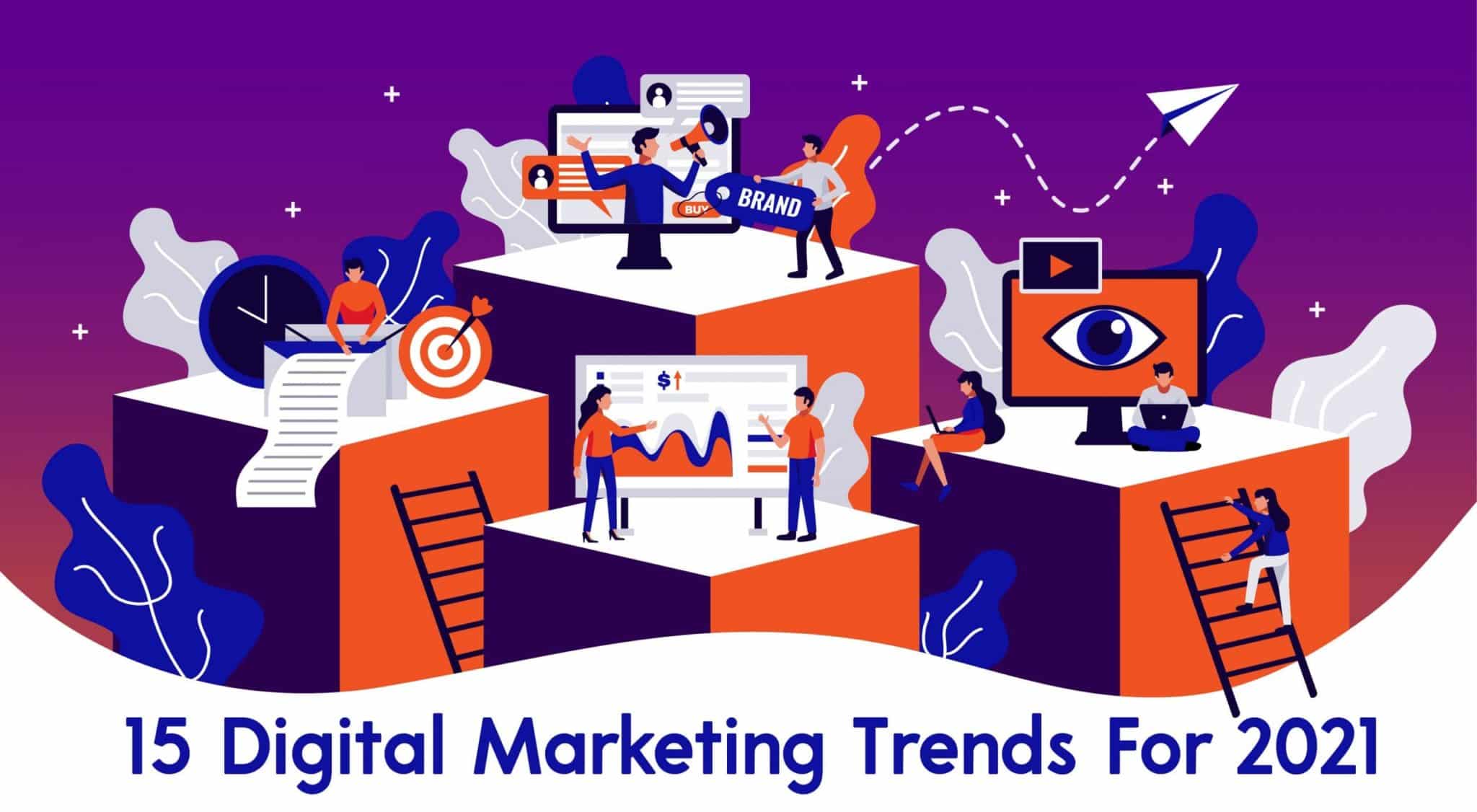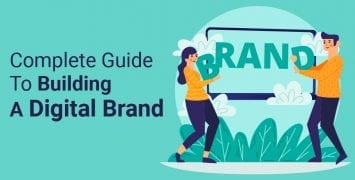Table of Contents
Introduction

After a year of unprecedented change, it’s time to look ahead to what the future of digital marketing holds.
We’ve done this by identifying the fifteen digital marketing trends that we think will become more relevant in 2021, based on 2020’s marketing landscape and the foreseeable changes that are headed towards the digital space.
We’ve done more than just deliver these trends to you, however. All in all, you’ll find the following discussed below:
- What digital marketing is and how it works.
- How digital marketing benefits marketers.
- The fifteen digital marketing trends we’ve identified.
- A summary of what we’ve learned/predicted.
Between these sections, we should have the needs of both beginner and seasoned digital marketers covered and ready to tackle 2021’s marketing campaigns.
What Is Digital Marketing?

On the face of it, digital marketing is exactly what it sounds like – the execution of set marketing goals through the application of digital technology.
With that said, marketing is a process that’s constantly evolving and, as it so happens, so is modern technology, so the word digital has had its definition tweaked several times too.
This can leave you in the dark as to what digital marketing is. You may have an idea, and you may be able to identify it when you see it, but what is it as an abstraction?
For our purposes in 2021, we’ve given you a handy rundown of what digital marketing entails and which elements of a given marketing campaign can be considered digital.
We, and others in the industry too, have boiled it down to five components:
- Digital Data
- Digital Devices
- Digital Media
- Digital Platforms
- Digital Technology
Digital Data
As any marketer will tell you, you need data, data, data, and with digital marketing, you get more data than ever to work with so that you can pick better targets and conduct an overall more successful campaign.
Of course, this unprecedented access to user data has led to data protection laws in most states and most countries, so marketers in the business of digital marketing would do well to understand how these laws work.
Digital Devices
Where does that digital data come from? From the devices that everybody uses to access the internet and the services on it, of course. Even if you’re a marketer, everybody is a consumer whose information is gathered and processed by computers, tablets, and smartphones in our life.
By considering these devices, you can tailor your marketing towards the user experience aspect of desktop machines and mobile phones so that your campaigns perform better in the digital sphere.
The meteoric rise of smartphones has yielded great marketing opportunities for those who know what they’re doing in the digital space, but we’ll go deeper into that aspect of digital marketing later.
Digital Media
As the hardware that we use has changed and has become more technologically capable, the media we view on our devices have undergone changes that influence how we market ideas, services, and products.
Social media is probably the standout development in communications in the last two decades, but this also includes digital mainstays like email campaigns and Search Engine Optimization, or SEO.
The core of marketing is putting your brand in front of people and, thanks to the rise of digital media and the fact that it can be accessed by everybody’s handheld devices, this has only become easier for digital marketers.
Digital Platforms
Acknowledging that digital media exists and staking your claim to it won’t be enough. You need to consider and carefully choose how much resources and time you invest in every digital media platform.
While browsers remain the most important, apps have been on the rise due to their seamless integration with digital device technology.
Whether it’s on a browser or through an app, you should know the best platforms to market on since you’re probably already on them yourself. Think Google, along with their subsidiary YouTube, and social media like Facebook, Twitter, Instagram, and LinkedIn.
Digital Technology
In talking about the data, devices, media, and platforms that you’ll use for digital marketing, we’ve only talked about the environment that digital marketers must navigate to be successful in this field.
With digital technology, however, we want you to think about how the technological innovations of the past decades can actively help you in your marketing endeavors.
You can find more information about these helpful marketing tools online, where they’re referred to as MarTech, but think of software that facilitates interactive website experiences or automates the emailing process.
Using digital technology in the marketing landscape is often seen as superior for two reasons, meaningfulness, and versatility.
Through the intimate process of showing up on someone’s handheld, engagement marketing has become easier than ever and brand awareness has become key to building customer relationships.
For versatility, the very nature of digital marketing makes it easier to take a multi-pronged approach to the market, known as an omnichannel strategy in the industry. This casts a wider net, obviously, which gets you more data and traffic to work with.
Of course, it’s also possible to define digital marketing by what it isn’t. For example, many of the traditional marketing practices like printed or broadcast media and telemarketing do not come under digital marketing.
For it to qualify as digital marketing, it usually must involve a computer with working internet while matching some or all of the above criteria.
What Are The Benefits Of Digital Marketing?
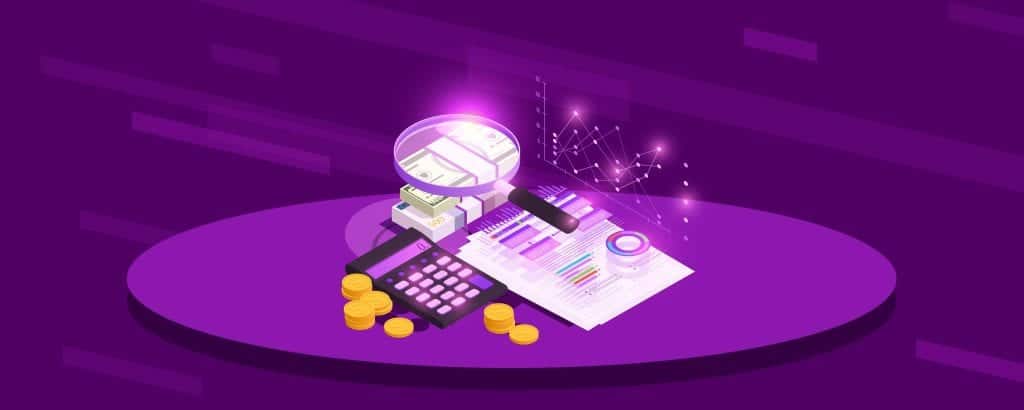
Well, before we get into specifics, you should know that digital marketing is needed nowadays if you want to compete.
It’s exceedingly rare nowadays that a business will get by purely on traditional marketing means and, given how inexpensive establishing a digital market presence can be, there’s no reason not to get your brand online and onto the screens of thousands of potential customers.
As we said, it also gives your brand access to a treasure trove of data that you can use to target, adjust, and tweak your marketing strategies.
So, what are these benefits?
- You gather data on your consumer base.
- It encourages good SEO practices.
- It allows you to establish a brand voice.
- It’s more fluid than traditional marketing strategies.
Let’s expand on these points so that we can all understand what makes digital marketing a beneficial addition to a marketer’s arsenal.
We’ve already mentioned how data is gathered via digital marketing and how you need to be aware of the relevant laws regarding your business, but what we haven’t covered yet is what that data is actually useful for.
With digital marketing, getting to know your consumer base is faster than ever, and it’s all condensed into quantifiable metrics that you can use to gauge your progress and make improvements. Picking your targets is much easier when you have all this information at your fingertips.
As part of this data, digital marketing more or less requires Search Engine Optimization. SEO ensures that your brand can even be found in the sea of businesses vying for the average customer’s short attention span.
Optimizers make great digital marketers because of this shared skillset and, conversely, using SEO for digital marketing builds a valuable skill set that can be applied to all kinds of projects that require an internet presence.
When establishing a brand presence online, the intimate and conversational nature of social media is ideal for getting close to consumers while finding your brand’s voice.
The brand voice has always been important for marketing since the way your business presents itself is key to relating to potential consumers, but the need for this has increased tenfold.
As we said above, you need to stand out, so find a voice that’s appropriate but different from what everyone else is doing and keep it consistent across all of your business-related communications online.
Ironically, though you have more data to work with than ever before, digital marketing is actually easier than a lot of traditional marketing strategies in terms of the logistics needed to get a project off the ground or change it mid-flight.
Part of this is the omnichannel capabilities we’ve mentioned, where it’s easier to cast a wider net to attract many people, plus everybody moves through the internet at a rapid pace and so advertising on just one platform won’t work.
That said, there are other challenges that come with the freedoms that digital marketing offers.
For example, yes, you’re able to communicate directly with potential customers via social media, but the best marketers then need to ask questions like “what time of day is best to post” along with other concerns regarding the content of messages and how this will change depending on the site.
For example, Twitter has a stricter character limit, Facebook has great group functionality, and Instagram is image-based.
15 Digital Marketing Trends For 2021

Now that you should have an idea of what digital marketing is and why you should consider entering the sphere if you haven’t already, let’s get into our fifteen most important predictions for 2021.
As informed estimates, they’re tailored by the marketing shifts of 2020 and, if 2021 is anywhere near as tumultuous by comparison, then we can expect to see even more drastic changes in that space.
With that said, most of the change has been positive towards the digital environment, so it shouldn’t be much of a concern, and these 2021 trends should see you through most of the year with success.
Conversational Marketing
As we mentioned when talking about your brand voice online, the immediacy of social media has seen a more conversational tone dominate over a more professional one.
There’s more to conversational marketing than just assuming a different tone, however, so let’s go through that and how it can help you improve your digital marketing game.
In a digital marketing environment, conversational marketing is where both human and AI-based chats are initiated with people when they visit your website.
Now, what do many webmasters put in place to greet people who make the journey to their site?
Forms, usually, and other data-collection methods that take time and effort for both parties, in both filling them out and having to wait to get the results from your visitors.

These older methods rely on email most of the time which, when compared to the conversational nature of a chat, leaves a lot to be desired from a customer engagement perspective. By making the on-site experience easier, you can convert more of your primed traffic to maximize profit.
Talking to a customer through your sales funnel is much easier than handing them paperwork to fill out. This principle has been the backbone of sales and door-to-door marketing but, in digital marketing, you have the added advantage that they’ve come to you first, making it less intrusive.
This is a trend that’s here to stay for the foreseeable future. In fact, the technology that facilitates conversational marketing is only going to improve as we head deeper into the 2020s, meaning 2021 is the perfect year to get on board.
Conversational marketing usually follows three basic steps, called the Conversational Framework as laid out by conversational marketing service Drift.com. These are:
- Engagement – You’ve probably been at the other end of conversational marketing engagement before.
Imagine this: You’ve visited a site and, in the bottom left or right corner, a sprite pops up to tell you that there’s a message you just received. Clicking it unspools a chat log where the site itself is trying to initiate a conversation. This is engagement.
Naturally, smaller and larger businesses rely on AI services to create these chats 24/7 without having to hire many people.
Other businesses in the sweet spot can hire real, living people as customer support for certain hours, where they try to prompt conversations with site visitors.
This is financially unfeasible for many businesses, however, and the ensured improvement of chatbot AI is making the automated option more attractive with every passing year.
- Understanding – We’ve mentioned sales and the human element that marketing has traditionally required, and an important part of conversational marketing is retaining that humanness.
You need to understand what the customer wants to find them the best product/service, after all.
You also need to get to that point in a relatively quick time. Five minutes, to be exact. After the five minute mark, the chance of qualifying any leads via conversational marketing plummets into infeasibility. Now you can see why getting your site a shiny, new 24/7 chatbot can be lucrative.
Program all of the standard and niche-specific qualifying questions and then let the bot do all of the work.
Pour as much of your own marketing knowledge into the bot’s construction by asking questions you would ask, if it were you, so that it doesn’t feel too, well, bot-ish. You can even program a conversational chatbot to be discerning, throwing out bum leads and prioritizing others.
- Recommendation – Once you understand what the customer wants, all that’s left is to recommend the closest product or service to them, simple as that.
Bots can be taught to do this too, but there are marketing purists who swear by keeping human staff to close deals.
A sales team that works in tandem with a bot should perform better anyway since they’re focusing everything on closing, just one part of your funnel, but also the most crucial part that brings in the cash.
Personalization

This one’s a mainstay marketing trend that isn’t going to go anywhere soon.
Potential customers react better when they feel they’re being appealed to as individual people, not a data point on a sales chart.
You don’t need a list of fancy statistics to guess that personalizing your marketing towards the target audience will yield better results, but here are some anyway.
We must also consider the technological implications of personalization going forward.
Consumers are spoiled for choice when it comes to entertainment and other leisure services in an increasingly interconnected world.
The businesses that will stand out will be the ones that take advantage of the newest and most consumer-friendly tech of the day, re-orienting it towards marketing.
Think of the rise of streaming services. They offer unparalleled personalization in what shows they recommend, and it’s done on an individual account-based basis since you’re in your house and not a movie theatre.
Now imagine that level of personalized marketing translated to every facet of life as everything becomes interconnected to smart tech gadgets and the learning AI within them.
Emerging examples of these are the smart refrigerators that recommend recipes after scanning their interior.
What if those smart household objects instead recommended products and services, from the comfort of your own home, after having learned your interests and predicted what buying outcomes you want, and when?
Inclusivity
Casting a wider net is usually a good idea if you have something to offer. In 2020 and beyond, topics like inclusivity are predicted to become even more relevant than they are in the workplace.
In terms of marketing, you want your product or service to be put in front of as many people as it can.
It was the digitalization of the world that has led to these marketing opportunities, so it only makes sense to target your digital marketing efforts at as large a crowd as possible.
Marketing that’s inclusive changes the way that consumers interact with advertisements, so inclusivity is something to keep an eye on during 2021.

Besides being beneficial, it also just makes sense.
Providing your product is right for your target audience, you won’t want to split that audience through changeable characteristics, so why would you want to alienate potential customers over characteristics that they cannot change?
Image and Video SEO
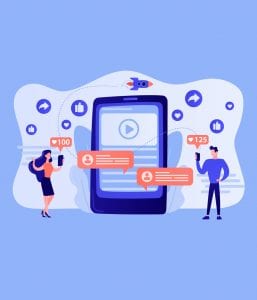
Keeping your SEO profile neat is key to marketing success in the digital world, but image and video SEO has been consistently overlooked in the past decade.
We predict that the 2020s is where that will change.
As the world becomes more digitized and marketers vie for an edge over their competition, it’s only natural that people will pay attention to the overlooked areas of SEO to rank on search engine results pages.
Ranking here is not only a consolation prize but, if successful, can then be a springboard to rank in standard written content on your site.
So, how do we suggest you optimize your image and video content? It’s relatively simple:
- Image Choice – Choosing the correct image is a good start, right? SEO practices won’t help that much if the images you choose are irrelevant or just plain bad, so get high-quality images.
Original images are great but this is outside the purview of many smaller businesses, of course, which is why great stock image archives like Shutterstock exist.
- Use Captions – Springing an image or video on someone unannounced can be confusing for some readers, so images have been captioned since the days of newspaper print for the sake of reader comprehension.
The same can be said for the digital world, but the algorithm likes it too. A line or two beneath the image or video you’re using goes a long way.
New visitors and the page crawler alike will scan-read your page and captions are a great way to catch their attention. As always, make sure they’re relevant and in the same tone as your body content.
- Remember Alt Text – Many people don’t even know what alt text is, so let us remind you. Alt-text is where information is portrayed in lieu of the image itself.
Whether it’s a problem on their end or yours, sometimes an image can’t show and this will harm their user experience. Adding alt text, usually in the form of a sentence describing the image, and utilizing a keyword to give more love to the SEO side of things is a great way to safeguard against this.
- Optimize File Name – Again, a relatively simple tip yet one of the most fundamental.
Keeping image names relevant to what the image or video is showing will help the page rank for image searches. Get rid of that string of numbers and give your file an actual name that’s detectable by the Google algorithm.
- Trim File Size – Loading times are important for on-page SEO. There’s no use getting people on-site if they won’t stay on-site.
We’ve all experienced a slow-loading page, so channel that frustration and leave this bad habit in the last decade. You can find plug-ins for WordPress and other similar resources that’ll automatically resize images and video for your page, finding an ideal balance between accessibility and fast-loading file size.
- Add A Transcript – For your videos, adding a transcript will be great for user engagement.
Whenever a video runs in the background, it’s usually running on mute and being ignored, but having a transcript and closed captions for that transcript means your videos can catch people’s reading attention without them actually watching and hearing the video.
And yes, the transcript is also better for bots to identify the content of the video, improving alternative search efforts.
- Meta Descriptions Matter – Ranking your image and video content will heavily rely on the titles and metadata present in that content.
Assuming you’ve got the title down, the meta description is what you should focus on next. Get some keywords in your video description, add a few relevant links but not too many that it’s obnoxious, and sneak the targeted keyword into your title if possible.
- Optimize For Mobile – This has been the trend for the 2010s thanks to the proliferation of smartphones and other handheld tech devices.
This means you’re probably already optimizing for mobile with your standard content, so why not your image and video content too?
Does your site twist itself into a pretzel when forced into a portrait aspect ratio? Stop that. Mobile viewing has overtaken desktop viewing, so make sure your image and video content are above board for this newly emerged medium.
- Make Good Content – We’ve said it before when discussing standard SEO – Content is king. Making sure your images and videos are what people want to see is the best way to get them noticed by visitors.
Of course, this applies more when you’re creating this content instead of relying on third-party sources but keeping the content relevant always helps. If your stuff is good, you might even get backlinks to your site which, as we know, is SEO gold.
Interactive Content
Along with the rise of smartphones and new innovations in site UX design, content interactivity has become more important in the last few years.
Interactive content keeps users engaged, increases on-page time, and leaves users with a more positive experience of your site.
That’s why we anticipate that standard content will continue transitioning to interactive content in the 2020s.
Think of quizzes/polls, AR advertising, and those 360-degree videos that have become popular on Facebook in the last few years.
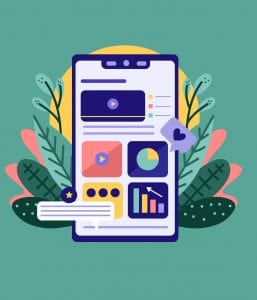
The Growth of Geo-Fencing
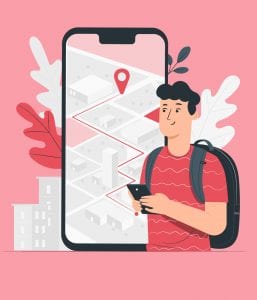
It’s easy to get lost in the digital world.
The interconnection of businesses all over the world via the internet is great, but nobody wants to be recommended the best businesses in Dubai when you’re in the States.
As we head deeper into the 21st Century, the sophistication of GPS and RFID tech will help in establishing geographic boundaries.
Think of how local SEO is important for local businesses, geo-fencing is the newest, shiniest tool for local SEO that can pinpoint locations and send ads, sometimes even notifications, when potential customers enter or leave your area.
Visual Search
As we said when talking about image and video SEO, searching by visuals is expected to become a breakthrough form of digital marketing in the 2020s.
As competition enters the traditional SEO realm and more pressure builds up in that space, more and more businesses will bleed into alternative SEO areas like visual searching.
If you’re savvy, you’ll want to make sure you’re at the front of that line.
The truth is that we already have ample visual search apparatus to work with, so check out the following services that place visual search capabilities into your hands:
- Pinterest Lens – Pinterest Lens is an app that allows you to take a picture with your mobile and see similar or relevant images on Pinterest. It’s as pure and immediate as visual searching can get.

- Google Lens – The same service exists with Google, where you get the might of the Google search engine condensed into your phone camera. It can identify product barcodes, books, buildings, art, flora/fauna, and home good products.
- CamFind – This is another visual search app outside of Google and Pinterest, so those of you who prefer to market in more niche circles might find this app a better fit. It can find you price comparisons and even local movie showings if you scan posters.
- Bing Visual Search – Bing’s visual search isn’t so friendly to your mobile devices but it has a pretty unique feature – the Detail View.
This lets you focus on a particular element of an image, like a piece of furniture in a photograph of an entire room, providing a specificity that’s only possible with visual search.
Social Media Stories

After the success of Snapchat, we saw every major social media app introduce short form “story” content in the last decade.
Bitesize video content caters to the new generations’ craving for information in a format that’s easy to digest and quick to consume, which is just what we need in the 2020s where information overload is only going to get worse.
This presents a brand awareness opportunity for digital marketers, allowing you to communicate with your base and reach new audiences with small, quicker-to-produce content with great returns.
Browser Push Notifications
Everyone needs encouragement sometimes, and that’s why we’ve seen push notifications take off in a big way in the last few years.
Legislation like the GDPR has made email marketing more difficult, there’s still opportunity in the influence that browsers have on people’s consumed content.
When combined with personalization efforts, push notifications can be a great addition to your digital marketing arsenal in 2021 and beyond.
Also, don’t forget to look into push notifications for mobile, too.

Content Marketing Still To Dominate

The updates will keep rolling down from Google HQ in the 2020s.
It’s an obvious prediction but business’ digital marketing efforts have lived and died by these changes, and it’s that volatility that keeps content marketing fresh no matter what decade we’re in.
Lately, the folks at Google have been focusing on authoritativeness in their ranking sites.
This means well-researched and composed written content will still be the backbone of a competent digital marketing campaign in 2021.
Social Commerce and Shoppable Posts
The meteoric rise of social media has maximized sales opportunities across the board and with this, we’ve seen social media and e-commerce has become hybridized.
What does this look like?
Instagram Checkout was one of the first and foremost mainstream examples but Facebook has added entire sections to their user interface based on shopping and product commerce.
You and your business can access features like Instagram Checkout via Shoppable, a revolutionary affiliate marketing service that allows potential customers to make purchases from your site without leaving the comfort of their favorite social media site.

Artificial Intelligence

Far from the plots of sci-fi films, AI is a convenient force in the digital lives of everybody nowadays and, with some TLC, AI marketing can work for your business’ benefit too.
2020 was a big year for artificial intelligence and, like many of the tech innovations we’ve talked about today, we can only expect these features to get bigger and better.
AI intersects with many of the aforementioned trends too, so it can make balancing all of the trends on this list easier for smaller businesses.
For example, personalization becomes much easier when an AI can sort through and form consumer profiles.
What we will say, however, is that you should avoid AI content creation at the moment. It isn’t sophisticated enough, we’d say, so written content is better.
Thanks to the convenience and competitive edge that AI gives businesses, it’s both easier and beneficial for companies in 2021 to embrace their bot overlords to phase out the competition and execute more capable digital marketing campaigns.
Programmatic Advertising
Having mentioned AI, let’s talk some more about programmatic advertising. This is where AI is used to automatically buy ads that target specific audiences.
You may already be aware of a type of programmatic ad buying in the form of real-time bidding but the continued automation of this process in the 2020s is going to be very useful for smaller marketing entities.
By targeting keywords, time spans, and locations (including local SEO and geo-fencing), programmatic advertising can lower costs for small businesses and allow new marketing entities to compete in the digital landscape, which will change the digital advertising landscape in the next few years.

Influencer Marketing

We all know what influencer marketing is at this point. After the rise of social media, certain figures found success on these platforms to occupy a space between friends and celebrities.
These are influencers and nowadays, the largest ones pull in bigger audiences than traditional media.
Content creators on YouTube and Instagram often get advertisement deals where they can put your products or services in front of their sizable audiences, presenting an attractive opportunity for marketers.
It’s essentially using the current digital landscape to take word-of-mouth marketing to a very lucrative extreme because it’s often perceived to be more genuine than the canned, corporate advertisements that play on your TV.
Millions of hours are watched on YouTube every day, dwarfing the numbers that cable TV pulls in, and this is a trend we can expect to continue in the 2020s.
Since we already mentioned AI earlier, artificial intelligence can help in finding the right influencers in the right niches for your business to advertise in, to maximize interest and generate a positive ROI.
Influencers faking engagement and botting followers is a real risk, so doing your due diligence is important and the introduction of AI into this space is going to make that process easier and safer for smaller businesses.
Augmented Reality and Immersive Technologies
Our last trend is a continuing one that can yield a lot of innovation as we push further past 2021.
First, we can expect that augmented reality tech will outpace pre-existing virtual reality.
VR has been relegated to leisure-based activities while AR presents a unique opportunity for marketers to interface with the reality of a consumer.
The aforementioned visual search mechanisms like Google Lens and Pinterest Lens are already dipping their toes into this field but we can only expect more AR innovations in the future.
An early example we have is the digital application of makeup to the faces of customers as they browse makeup on their e-stores.

IKEA also has digital stores where you can look at furniture without hauling yourself to the nearest IKEA store, plus you can manipulate these 3D renders in a way that just isn’t possible in the real world.
Along with AR, we can only look forward to new immersive technologies in the digital marketing space that will add more arrows to a marketer’s quiver.
To that end, we advise that savvy marketers keep their ears to the ground and watch for coming tech innovations because getting on board with these emergent trends at the ground level can make your future business.
Summary
That concludes our rundown of fifteen digital marketing trends that we expect to emerge, or continue growing, in 2021 and the succeeding years.
Whether you’re focused on SEO, visual content creation, or you run an e-commerce business, you can find useful practices above that are best integrated into your style of doing business.
Since you operate in the digital marketing sphere, it’s also important that you stay flexible.
You’re working in an industry where a simple algorithm update can see certain practices fall out of favor, so you need to make sure you can adapt your digital marketing strategy to fit the environment you’re operating in.
A year is a long time online, so we could be looking at a different landscape for marketers when 2021 comes to an end.

